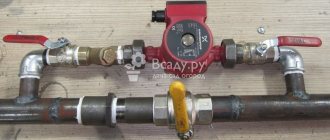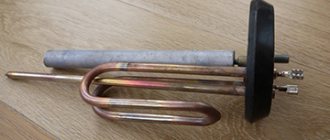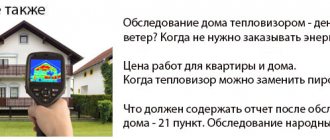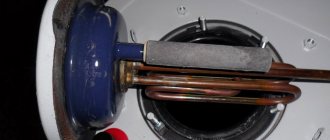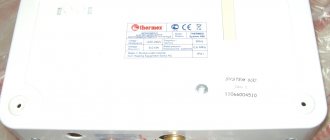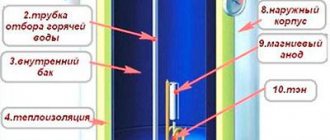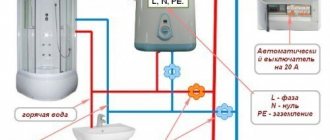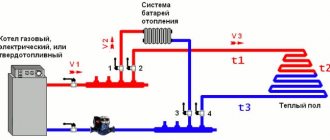Categories of heating elements by type of contact with liquid
In a dry heating element, there is no contact with water, which prolongs the service life of the part.
Inside the heating element, a nichrome spiral is hermetically sealed to heat water, and the space between it and the outer walls is filled with quartz sand. The outer tube can be made of copper, carbon steel or stainless steel.
Open heating elements come into direct contact with water. Their main advantage is the high speed of heating the liquid and low cost, but there are also significant disadvantages:
- limited service life;
- rapid formation of limescale;
- high electricity consumption;
- insecurity.
Closed ones do not come into contact with water. The heating element is protected by a durable bulb. Its advantages:
- the likelihood of an electrical short circuit is reduced;
- easy to repair and maintain;
- serve for a long time - three times longer than open heating elements;
- consume significantly less electricity than open-type heating elements.
There are two important disadvantages: high price and slow water heating.
Criterias of choice
When choosing a heating element for a boiler, you need to build on the characteristics of the previously installed element.
Types of devices

. In addition to the type of heating element in contact with liquid, you need to take into account a lot of other parameters:
- Mounting method: nut or flange. The latter can be cast or stamped. Flange mounting is typical for open-type heating elements;
- Possibility of installing an anode - this element is designed to protect metal surfaces from corrosion and scale, thereby increasing the overall service life of the boiler. The anode gradually “melts”, so a new one must be installed periodically. If there is a hole for the anode in the base of the heating element, then a new heater with the same hole is needed.
- The shape depends on the type of storage container. The heating element can be straight or bent. A heating element similar to the previously installed one is selected, taking into account not only the shape, but also the size, as well as the bending angle.
- Material of manufacture - the outer surface of the heating element can be made of copper or stainless steel. It is important that the material of the tank and heating element match, otherwise, due to the difference in potential, the service life of the heating element and the tank itself will be shortened. A closed-type copper heater can be located inside an enameled steel flask, in which case you don’t have to worry about creating a galvanic couple.
Heating elements made of stainless steel are characterized by increased resistance to corrosion, and copper ones have greater thermal conductivity.
Features and amount of heated liquid

If the water is hard, you need a heating element under the anode, which will partially eliminate the problem of scale and extend the life of the boiler. The power must correspond to the volume of the heated liquid. It is recommended to purchase a part of the same power as the failed one. The heater parameters are indicated in the technical data sheet of the device.
terms of Use
The power must match the wiring capabilities. But this applies more to the choice of a boiler rather than a heating element, since the old element is replaced with a new one of similar power. The power of the boiler as a whole also affects the heating rate of a given volume of water. If the heating element is low-power, for example 1000 W, and the capacity is 80 or even 100 liters, it will take a very long time for the water to heat up to the maximum temperature, several hours, so you need to turn on the boiler in advance. This power is optimal for small boilers, up to a maximum of 50 liters.
If you plan to consume a lot of hot water, it is recommended to buy a model with two heating elements. They heat the water faster. In economical mode, one element will work, and the second will be connected thanks to the thermostat when it is necessary to heat a new portion of cold water.
Tubular electric heaters come in different capacities
To calculate the required power of a water heating element, a special formula is used that takes into account the volume of water and its initial temperature, the temperature to which the water needs to be heated, as well as the time during which this must happen.
, Where
P — heating element power, kW;
V is the volume of heated water, liters;
tk is the final water temperature, degrees Celsius;
t n - initial water temperature, degrees Celsius;
T—water heating time, hours.
Thus, if you want to boil 10 liters of water at room temperature in 10 minutes, you will need a 5.5 kW heating element.
Types of heating elements according to operating principle
The features of open and closed heating elements are clear from the name. The former are not protected from water, the latter are covered with a flask. They are also called wet and dry. The principle of their operation should be considered in more detail.
Wet
Wet-type heating elements are tubular, they are in direct contact with water and heat the water with their surface. Their service life depends on the quality of the water, its hardness, and the percentage of salts. Due to the influence of these factors, the metal corrodes, and limescale forms on the surface. By installing a magnesium anode, the process can be slowed down, since the element attracts salts. Vitreous enamel is also used to protect water heating tubes.
Dry
A dry heating element is a heater that is placed in a flask filled with a second layer of ceramic backfill (the first layer fills the space between the nichrome spiral and the tube in which it is placed). The waterproof shell is made of magnesium silicate or steatite. Soapstone heats up quickly and cools down slowly, has increased strength and high heat resistance. The advantages of using a dry heating element in a water heater outweigh the disadvantages, and in particular, to replace such a heating element, you do not need to drain the water from the boiler.
The heating element of a dry heating element does not come into direct contact with water, but due to an increase in the thickness of the element, its thermal conductivity decreases, and the water heats up more slowly at the same power. At the same time, the heat transfer area is increased, which makes it possible to somewhat compensate for this disadvantage.

A protective flask on a dry heating element prevents contact with water

Wet heating element - there is an anode for protection
Closed heating elements (“dry”)
Such heating elements are a special heating element, which, in fact, is isolated from the entire surrounding world by a special ceramic bulb in which it is, in fact, located. Typically, this cone is subject to strict requirements in terms of strength characteristics. When making a flask for a “dry” heating element, steatite or magnesium silicate is used, while the heating element itself in this case is made of “stainless steel”. It is for this reason that the liquid in closed-type water heaters is heated by heat transfer from the casing.
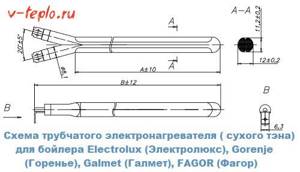
Strengths and weaknesses of devices
There are several advantages here, let's take a look at them. First of all, thanks to the closed design, such devices are completely safe during operation, since the risk of short circuit is eliminated. In addition, these heating elements:
- can be repaired without much difficulty;
- easy to use and maintain;
- economical;
- have a fairly long service life.
Note! The heating element, insulated by a ceramic bulb, is a solid element, and its surface is an effective transmitter of thermal energy.
The flange, as well as the storage tank, in such boilers is reliably protected due to the presence of an enamel coating that prevents the appearance of scale. By the way, this is why the service life of “dry” elements is approximately three times less than that of the “wet” ones described above. As for the disadvantages, they include, first of all, the fact that all soapstone heaters can hardly be called universal. The fact is that they are produced separately for each type of water heater, while taking into account the fact that, if necessary, the element will be replaced with a similar one.

How to properly replace the heating element in a boiler

The need to replace the heating element arises when it malfunctions. When it stops heating the water, the electrical protection device is triggered. The average service life is 4 years. Then it fails due to increased water hardness. This event can be delayed if you perform annual boiler maintenance: clean the heating element and magnesium anode from scale. This operation will increase the duration of operation and improve the quality of water and the rate of its heating. Before purchasing a new element, you should check the condition of the old heating element using a test lamp or multimeter. In the first case, a simple electrical circuit is assembled, including a lamp and a heater. If the light is on, it is not the problem. In the second case, the resistance is measured with a special device. A zero value indicates a heater malfunction.
The designs of different boiler models have minor differences, but the principle of replacing heating elements in a water heater is the same for all types of devices.
To begin with, turn off the water supply and drain the remaining liquid from the boiler. The water heater must be de-energized by unplugging the plug from the socket. At the bottom of the boiler there is a cover that is attached with screws. You need to unscrew them with a screwdriver and the cover will come off. For safety reasons, before you start replacing the heating element in the boiler, you need to check the presence of voltage at the terminals, for example, using an indicator screwdriver. Then disconnect the wires and unscrew the nuts holding the heater in place. Replace the heating element on the water heater, first checking that the contacts are dry. If an anode is installed in the boiler, replace it as well. Check the seal for leaks and screw the lid into place. After these manipulations, you need to fill the boiler with cold water and bleed the air from it by opening the hot water tap. Only now can you turn it on to the network.
Exploitation
Infrared heater: manufacturers and types
Heating elements most often break down precisely due to improper use of water heating devices. Due to any malfunctions in operation, the following problems with the heating part are possible:
- metal bursts due to prolonged exposure to high temperature or stress;
- the shell loses its initial seal, which leads to immediate breakdown of the heating element;
- rust particles and signs of structural destruction appear due to improper handling of the heating device;
- failure due to long-term violation of safety and maintenance rules.
The list of possible problems is not limited to the above list. In general, each violation leads to one or another unique breakdown. For example, even in the case of an incorrect attitude to the volume of liquid, the heating element can fail (if the tank has a volume of 80 liters, the space must be filled so that the heating element is completely immersed in water).

Types of heating elements for an 80-liter boiler
Popular manufacturers

You should choose heating elements from a trusted manufacturer. This is not an element you need to skimp on. The best companies include:
- Thermex. It has been producing boilers for almost 50 years. This manufacturer produces heating elements from copper and stainless steel. They are reliably protected and therefore have a long service life. In the market, Termex has established itself as a manufacturer of boilers of the largest volume, so you can find powerful electric heaters in its assortment.
- Ariston. The heating elements from the Italian manufacturer are made of an alloy containing copper and equipped with a chromium-nickel tube. The flange is made of brass, which increases heat transfer. They are well protected from scale and easy to install. And at the same time they are relatively inexpensive. Ariston offers water heating heating elements with threads and a thermostat from 1.2 to 4.5 kW.
- Electrolux. You can choose a heating element from this manufacturer for almost any heater model. At the same time, they are guaranteed to last a long time, since they are especially resistant to scale and are not demanding on water quality. A water heater with a heating element from Electrolux does not require frequent maintenance. Some devices from this manufacturer are equipped with two closed heating elements, so it is possible to increase the heating rate of the liquid.
- Timberk. Another manufacturer that offers its products at an affordable price. The assortment includes heating elements designed for boilers with 80 or more liters of water. They are well protected from corrosion and other destructive factors.
- The company Atlantic is also known. It produces a wide range of high-quality and reliable heating elements for boilers, including copper water heating elements, dry soapstone and others, suitable for vertical and horizontal installation.
Each manufacturer produces electric heaters designed for installation in boilers of their own production. However, you can also find universal heating elements. They are less popular due to their dubious quality, but their use is possible.
Without a heating element, the boiler cannot operate. This is the most important element, which is selected taking into account the volume of the water heater and the characteristics of water consumption. Be sure to take into account which heating element was previously installed in the boiler. It is advisable to choose exactly the same or as close as possible in terms of characteristics. You can replace the faulty part yourself.
